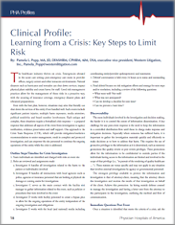Resource:
Learning from a Crisis: Key Steps to Limit Risk
Good risk management practices allow for the management of those risks in a proactive way.
The health care field thrives on crisis. Emergencies abound in the acute care setting; post-emergency care exists in provider offices, surgery centers and other nonacute environments. Natural disasters such as hurricanes and tornados can shut down services, impact physical plant stability and create havoc for staff. Good risk management practices allow for the management of those risks in a proactive way, with the securing of insurance coverage, emergency disaster plans and rehearsed preparedness.
Even with the best plan, however, situations may arise that literally can shut down the services of the entity if not handled well. Such events include significant patient injuries, multiple harm exposures, media attention, political sensitivity and board member involvement. Each unique and complex, these situations require a formalized crisis response — a prepared response that addresses all aspects of the event from investigation to agency notification, evidence preservation and staff support. One approach is the Crisis Team Response (CTR), which will provide mitigation/resolution recommendations to senior management, result in complete and protected investigation, and can empower the site personnel to continue the ongoing operations of the entity while the crisis is addressed.
Outline Steps/Timeline for Crisis Investigation
- Team individuals are identified and charged with roles at event site
- Roles are reviewed and assignments made
- Investigator A handles all investigation related to the harm to the patient or individual(s) involved
- Investigator B handles all interactions with local agencies such as police, agencies or insurance personnel that are looking at physical site damage or coming onsite for investigations
- Investigator C serves as the main contact with the facility risk manager to gather information related to the event, such as policies or procedures that were involved in the event
- Investigator D works with facility personnel to create a bypass plan to allow for the ongoing operations of the entity independent of the ongoing investigation and obligations
- Investigator E works with the local (and national) media including coordinating entity/provider spokesperson(s) and statements
- Debrief conversation is held every 24 hours as to status and outstanding issues
- Final debrief focuses on risk mitigation efforts and strategy for next steps and/or resolution, including a review of the following questions:
- What went well? Not well?
- What was not anticipated?
- Can we develop a checklist for next time?
- Can we prevent a ‘next time’?
Discoverability
The more individuals involved in the investigation and decision making, the harder it is to control the extent of information dissemination. A key challenge for any post-event response is the need to keep the information in a controlled distribution flow until those in charge make response and mitigation decisions. Especially where someone has suffered harm, it is important to gather the investigation materials quickly and efficiently to make decisions as to how to address that harm. This requires the use of protective privileges to the information as it is determined, such as statutory protections like quality review or peer review privileges. These protections allow for the information to be confidential to outside parties if the individuals having access to the information are limited and involved in the scope of that privilege (i.e., “in pursuit of the rendering of quality healthcare …”). These statutes are venue specific and may not apply in any situation that involves external investigations by agency or governmental personnel.
The strongest privilege available to protect the information and investigation is that of attorney-client, meaning that the attorney directs the investigation and receives the results of that investigation on behalf of the client. Achieve this protection by hiring outside defense counsel to manage the investigation and having a letter sent from the attorney to the participants in the investigation, outlining the method and flow of communication.
Immediate Questions Post Event
Once a situation is identified that meets the criteria of a crisis, ask the following follow-up questions:
- Is there injury? Is the injury actual harm or more theoretical, such as fear of exposure to an illness or disease?
- Who is injured? One person or more? Has a single individual or a group suffered the harm? Is the group identifiable?
- Will the injury continue to happen without action? What action? Is the event singular (a suicide) or ongoing (exposure to unsterilized equipment)? Has action been taken to stop the harm (such as removal of malfunctioning equipment)?
- Is there a need for public disclosure? Is education needed for the community as well as for the individual(s) affected? Are there obligations to report to public/private entities?
- Is there a need for testing/treatment? What will address the harm? The psychological effects — fear of future harm?
- Is there funding for the response? Is the funding available through designated insurance coverage? Will the expenses for the response come from operations or other sources? Does that funding require reporting to an external entity, such as insurance agent or carrier?
Reporting Obligations
In the midst of an investigation, it may be easy to overlook reporting obligations that may arise from managed care entities, state or federal agencies, or insurance requirements. However, these reporting triggers may have significant penalties for delayed or deficient reporting and should be reviewed annually to prepare for necessary reporting in a crisis situation. Some managed care contracts may even require reporting when a nonbeneficiary is involved in a significant patient care event, and thus confidentiality provisions must be considered as well.
Because the contractual or statutory language governing these relationships can be complex, it is recommended to create a spreadsheet of reporting requirements for ease of subsequent reference. Headings might include the following:
- What is the name of the entity/insurer/ agency?
- What is the reporting trigger or definition? How broad is the definition?
- What, if any, privileges apply when information is released to this party?
- Is there an indemnification for a breach of confidentiality of this entity from the information shared?
- What is the required timeline to report?
This spreadsheet can then be used during the investigation, because the reporting requirements may change based on what information is learned. Reporting should be considered an ongoing obligation and considered at each debrief to determine timeliness of reporting.
Investigation Documentation to Secure
Regardless of the type of event, the securing of key evidence will be crucial to a successful result, whether through proactive resolution or litigation. Electronic forms of documentation should be secured through a litigation hold — the ceasing of communication use and securing of any involved communication means, such as specific computers — and physical documentation secured and controlled to prevent alteration or destruction. Access to the information during the investigation should be limited to those involved in the crisis response.
Areas of documentation specific to the facility include:
- Incident reports
- Admission/intake documentation
- Policy/procedures
- Remedial measures
- Agency findings
- Contractual documents
Also include documentation specific to the personnel involved in the treatment of the patient or the event: • Contact information for involved personnel
- Emails, memos, etc. between personnel
- Contracts with involved providers
- Post event resources offered — counseling/crisis debriefing benefit information
And if a patient is harmed, retrieve and secure documentation as it relates to the specific individual involved:
- Medical records — including all consents
- Alternative Dispute Agreements (ADR) language
- Photos, drawings of the location
- Post event responder records
- Disclosure conversations
- Obituary or press coverage
- Social media information (Facebook, webpage)
- Surveillance/security videos from any facility areas
Convert Findings into a Risk Plan
After the event is investigated and a resolution plan put into place, convert the findings into a risk management plan for the future. Focus the plan on preventing a repeat event, updating any operational measures (such as policies/procedures) and re-establishing trust between personnel involved. The action plan can be used to encourage the staff and providers to learn from the event and find closure in its resolution. It also provides feedback to the senior management of the organization to show that the lessons learned from the event were being incorporated into the operations of the entity.
The action plan should answer the following questions:
- What systemic changes will prevent reoccurrence?
- How will the action be measured or monitored for compliance?
- What reporting response is needed?
- How will the outcome be conveyed?
- How will the remedial measures be implemented?
Final Thoughts
Not every crisis can be anticipated; therefore, even the best risk management program may not be able to sufficiently respond when a significant event occurs. Implementing a team approach, such as the CTR model, allows for the effective and efficient delegation of investigation while stabilizing the ongoing operations of the entity. :
Recommended Resources
- The Disclosure Dilemma – Large Scale Adverse Events, N Engl J Med 363; 10. (Sept. 2010)
- Critical incident reporting and learning, B J Anes 105(1); 69-75 (2010).
- How to make a large scale disclosure of a medical error, Zurich Perspectives, Vol. 15, No. 3 (2009).
- Crisis Management: responding effectively to media inquiries, CNA Alert Bulletin, AB 09, Issue 6.
- Guidelines for Informing the Media After An Adverse Event, CPSI ICSP, Canadian Patient Safety Institute.
SOURCE: Physician Hospitals of America, By: Pamela L. Popp, MA, JD, DFASHRM, CPHRM, AIM, DSA, executive vice president, Western Litigation, Inc., Pamela_Popp@westernlitigation.com, Fall/Winter 2011 19

